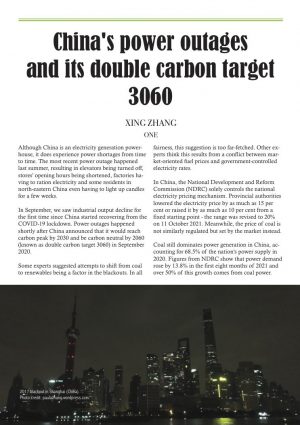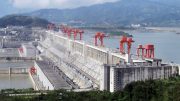 Although China is an electricity generation powerhouse, it does experience power shortages from time to time. The most recent power outage happened last summer, resulting in elevators being turned off, stores’ opening hours being shortened, factories having to ration electricity and some residents in north-eastern China even having to light up candles for a few weeks.
Although China is an electricity generation powerhouse, it does experience power shortages from time to time. The most recent power outage happened last summer, resulting in elevators being turned off, stores’ opening hours being shortened, factories having to ration electricity and some residents in north-eastern China even having to light up candles for a few weeks.
In September, we saw industrial output decline for the first time since China started recovering from the COVID-19 lockdown. Power outages happened shortly after China announced that it would reach carbon peak by 2030 and be carbon neutral by 2060 (known as double carbon target 3060) in September 2020.
Some experts suggested attempts to shift from coal to renewables being a factor in the blackouts. In all fairness, this suggestion is too far-fetched. Other experts think this results from a conflict between market-oriented fuel prices and government-controlled electricity rates.
In China, the National Development and Reform Commission (NDRC) solely controls the national electricity pricing mechanism. Provincial authorities lowered the electricity price by as much as 15 per cent or raised it by as much as 10 per cent from a fixed starting point – the range was revised to 20% on 11 October 2021. Meanwhile, the price of coal is not similarly regulated but set by the market instead.
Coal still dominates power generation in China, accounting for 68.5% of the nation’s power supply in 2020. Figures from NDRC show that power demand rose by 13.8% in the first eight months of 2021 and over 50% of this growth comes from coal power. Unsurprisingly, the NDRC also reported that thermal power generation (mostly coal) grew by 12.6% during this period. But coal production was up by only 4% and coal import reduced by 3.6%.
The growth in energy demand and lack of coal supply pushed coal prices to a record high. As a result, the power companies were unwilling to produce adequate power because it was simply not profitable. Over 90% of power plants have recorded losses in recent years. Some utility firms, especially private players that rely on spot coal, did not want to purchase coal and had to reduce generation.
To stabilise coal prices, the NDRC announced on 11 October 2021 that they would adjust the floating range of market-based electricity transaction prices in principle to a two-way range of 20%.
The 20% fluctuation limit does not restrict rates for coal-fired electricity for energy-intensive enterprises. The new mechanism is based on a benchmark price plus a floating range, after considering costs, reasonable margins and market changes. China’s coal prices started to plunge after the government announced new regulation.
China gave power plants the freedom to negotiate long-term contracts with grid operators within a specific price band. Because the country has overcapacity in coal-fired power, the grid operator had the pricing power, and generators bid low, further lowering power prices.
Although power plants run at a loss, grid operators are still making profits. For example, in 2020, the National Grid made 450.9 billion Yuan profit, while the Southern China Grid made 100.8 billion Yuan. Increasing the feed-in tariff and balancing up profits distribution between power generators and grid operators will undoubtedly help to encourage power generators to produce more electricity.
However, it questions whether the energy crisis will affect China’s determination to tackle climate change and finally move away from coal.
On 24 October 2021, the Chinese government issued top-level guidance on carbon peaking and carbon neutrality: retaining double carbon targets 2060, strictly controlling coal consumption between 2021 and 2025, and reducing coal consumption between 2026 to 2030. However, a new principle was introduced in the action plan for carbon peaking that followed: carbon cuts must happen in a secure and orderly manner. The world also witnessed China teaming up with India, forcing the word change from ‘phase out’ to ‘phase down’ coal at COP26 on 13 November.
On 17 November, the State Council stressed that China’s energy resources are dominated by coal and ordered to improve the level of clean and efficient use of coal.To achieve its double carbon targets 3060 and build a new energy system with renewable energy dominating, China will retain coal power to guarantee supply and provide flexibility. But to what level? Recent research by the University of California, Berkeley, analysed scenarios in which China was not reliant on coal power.
Under a high power demand scenario, assuming an average annual power demand growth of 2.7% between 2018 and 2040, China would need to retain 310 gigawatts (GW) of coal power for reliability needs. Under a low demand scenario, of 1.9% annual growth in demand, the entire coal power fleet could be replaced by a combination of wind, solar and energy storage by 2040.
The difference between the two scenarios highlights the critical importance of managing power demand. Under the low demand scenario, to phase out coal power by 2040 would require annual increases of between 100–150 GW of solar and wind capacity and 15 GW of energy storage between 2020 and 2025. Then 250 GW of solar and wind power and 90 GW of energy storage will be needed to be added annually from 2025 to 2040.
China currently has around 1,100 GW installed capacity of coal power in place. The power outages resulted from coal and electricity pricing mechanism rather than capacity shortage. In fact, coal power has significant overcapacity in China, with typical plants running at less than 50% of their capacity. To ensure its 3060 double carbon goals becoming a reality, China at least has to stop building new coal-fired power plants immediately, audit current coal power capacity and resolve overcapacity.
The Chinese government also needs to issue guidance on replacing the coal plant fleet with zero carbon alternatives as soon as possible.
Xing Zhang





